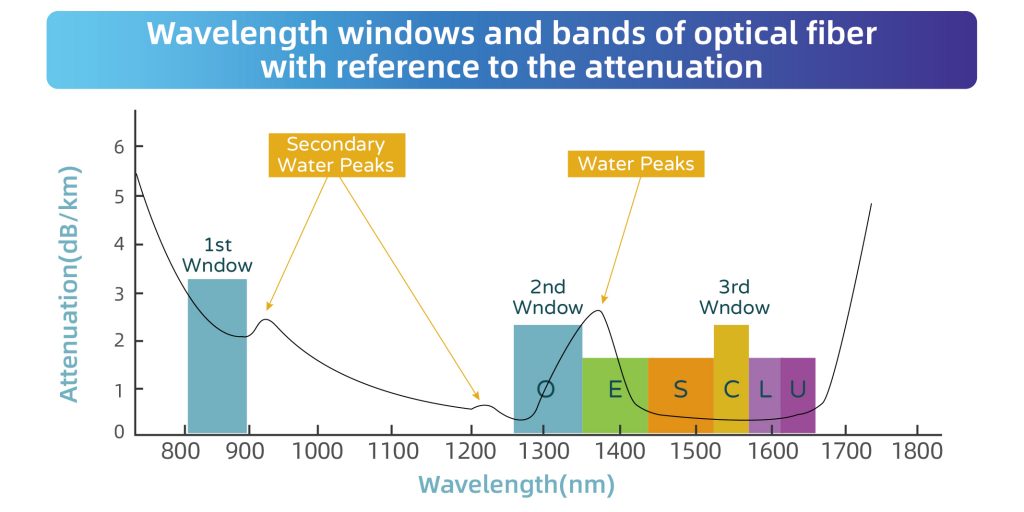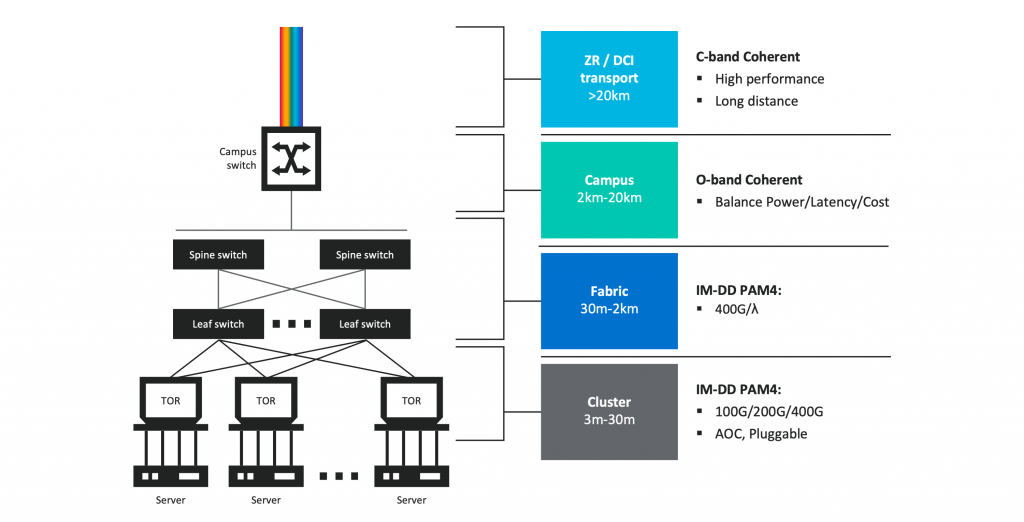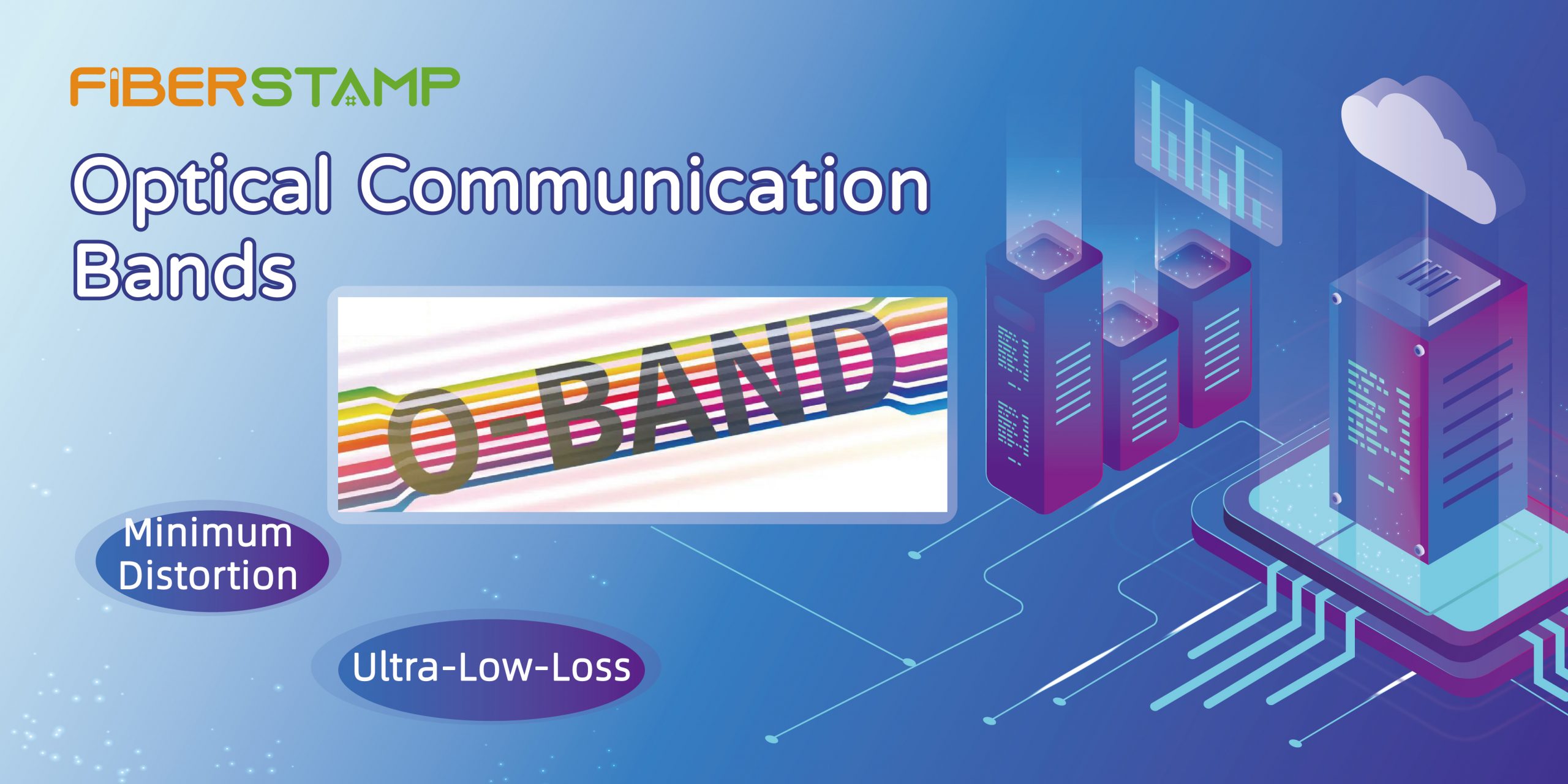The higher the speed of optical communication, the more affected by dispersion. The “low loss wavelength region” optical band from 1260nm to 1625nm is most suitable for transmission in optical fibers. The transmission loss and optical band relationship is shown in the following figure below.

Figure 1 – The relationship between the transmission loss and optical band
The O-band wavelength ranges from 1260nm to 1360nm. The signal distortion caused by light dispersion in this band is minimal and the loss is low, which is an early optical communication band. Hence the name O-band (O-band), where O means “Orignal”.
O-band In Perfect Availability For 5G Front-hual
The unique advantage of the O-band is that it is in the low dispersion region, and under NRZ modulation, as the rate increases, the sensitivity to dispersion will also increase. “The advantages of O-band, low dispersion and low cost, can provide guarantees for 5G front-hual transmission performance.”
Currently, the O-band LWDM applied to 5G front-haul adopts a mixed rate WDM system of 25Gb/s and 10Gb/s. 25Gb/s request O-band DWDM, 12-channel BiDi, 800GHz interval, using DML+PIN+TEC; The 10Gb/s request CWDM, 12-channel BiDi, 20nm interval, using DML+PIN. In terms of standardization, 25Gb/s LWDM meets the ITU-T standard definition of DWDM.

Figure 2 – Hybrid transmission with 25Gb/s and 10Gb/s
O-BAND DWDM Non-coherent Transmission Solution
Fiberstamp’s 100G PAM4 DWDM O-BAND solution is designed for customers who require multiple 100G connections over medium length distances. 100G QSFP28 DWDM1 O-BAND Silicon optical series adopts 150Ghz O-BAND DWDM Grid, adopts single-wave 100G PAM4 silicon optical modulation technology platform, adopts Duplex LC interface, provides 16 wavelengths optional. The total bandwidth of 1600G is realized on the dual-fiber single-mode fiber, which meets the 5G fron-haul transmission and DCI interconnection, and 30km transmission can be achieved under the support of SOA optical amplifier (10km transmission without external SOA), without the need for dispersion compensation DCM module. The power consumption less than 3.5W. Compared with coherent DWDM, this scheme has the advantages of low cost, low delay, low power consumption and easy deployment.

Figure 3 – 1600G Transmission Solution with O-BAND 100G QSFP28 PSM DWDM1
Color X 100G QSFP28 DWDM1 O-BAND 10km
- 100G PAM4 silicon optical MZ modulation technology
- The electrical port side adopts 4X25G NRZ with built-in FEC-KP4
- DWDM O-BAND 150GHZ, 16 channels
- can be transmitted for 10km
- with an external SOA, it can transmit 30km in a single span segment
- Power consumption is expected to be less than 3.5W
- for 5G pretransmission and DCI interconnection
Fiberstamp’s 100G QSFP28 PSM DWDM4 for Non-Coherent long-distance Subsystem. These modules, built upon a 4x25G NRZ quad-carrier DWDM solution, offer options in C-band and O-band spectra, effectively spanning distances exceeding 80km. Here we will introduce the 100G QSFP28 PSM DWDM4 O-band optical transceivers.
In a dual-fiber configuration, the module delivers a total network bandwidth of 400G. It can be directly inserted into a 100G QSFP28 switch port, eliminating the need for traditional DWDM optical layer equipment and dispersion compensation modules.

Figure 4 – 400G Transmission Solution with O-BAND 100G QSFP28 PSM DWDM4
Color ZR+ 100G QSFP28 PSM DWDM4 O-BAND
- 4x 26Gbps NRZ per channel O-band 150GHz DML DWDM transmitter 16CH wavelengths and PIN photo detector array receiver
- Supports 4 channels of bidirectional 100G or unidirectional 100G business access.
- Offers multiple customer-side business interfaces: 100G Base-SR4/CWDM4/LR4/PSM4.
- Line side supports 2 channels of coherent CFP2 optical modules at 200G.
- Enables DWDM transmission and wavelength conversion.
- Utilizes SNMP-based unified network management platform.
- Features CDR function for optimizing output and monitoring DDM signals.
- Supports software-based port shutdown.
- Up to 80km reach for G.652 SMF with external Mux/Demux,daul SOA
- Up to 10km reach for G.652 SMF without external SOA
- Low power consumption <5W
- Single male MPO-12(APC 8-degree) connector receptacle
O-BAND Next-generation Coherent Communication Solution
The specialist of transmission technology put forward a hypothesis that “cloud and hyperscaler have promoted the PAM4 industry in the past ten years, and the AI cluster may incubate the coherent 20km scene in the next ten years”. There is also an articel about coherent from Marvel, it says that AI has higher bandwidth requirements than traditional cloud servers, and as data centers’ demand for bandwidth grows, they will need to scale data centers in multiple dimensions, including building larger data centers and adding longer internal connections. The O-Band Coherent has been in discussion for years but has not yet to be deployed commercially on a large scale.
The O-band Coherent technology platform uses low-dispersion O-band wavelengths, so there is no need to design complex dispersion compensation algorithms like C-band. However, for the short distance typical interconnection of 500m to 10km in the data center, it is more economical to build optical networks using O-band. Fixed wavelength lasers operate at around 1310nm, providing a significant advantage in terms of cost, as dispersion is not a major issue. Since the O-band does not need to mitigate CD and DGD, the complexity of optical DSP can be simplified. It will reduce the technical complexity of DSP and reduce the power consumption and latency. Using coherence technology in combination with O-band optics can extend transmission distance, increase bandwidth, and reduce the cost of optical transceivers. O-band may be also able to provide the performance required to replace standard coherent technologies in campus environments to save energy.
In the next few years, as the demand for AI rises, it may gradually enter the market. Coherent technology is traditionally used to connect geographically distant data centers, but for the typical interconnection distance of 500m to 10km in a data center, it is more economical to build an optical network using O-Band, which can extend transmission distance, improve bandwidth, and reduce the cost of optical transceivers.

Figure 4 – 400G/800G Coherent Optical Transceivers
O-Band Coherent: An Idea Whose Time Is (Nearly) Here
Over the past 20 years, the data rate of optical technology has increased by a factor of 1,000 while the power consumption per bit has decreased by a factor of 100, an amazing trajectory that has in many ways paved the way for cloud computing, mobile Internet and streaming media.
AI represents the next turning point in bandwidth demand. Servers powered by AI accelerators and Gpus have greater bandwidth requirements than typical cloud servers: just seven high-end Gpus are enough to exhaust switches that can typically handle 500 cloud dual-processor servers. Equally important, the demand for AI services, as well as higher value AI services such as medical imaging or predictive maintenance, will further drive the need for more bandwidth. The AI market is expected to reach $407 billion by 2027.
O-band coherent or coherent streamlining – a technology that has been discussed at conferences for years but has yet to be deployed commercially in a meaningful way – may begin to penetrate the market in the coming years, helping cloud service providers address some of these challenges.
Coherent technology has traditionally been used to connect geographically distant data centers with connections spanning more than 100km. In terms of optics, DWDM technology using tunable lasers in the C-band is a must for long-distance transmission to save fiber costs and maintain performance. When operating at C-band, coherent DSP are needed to mitigate optical obstacles such as dispersion (CD) and differential group delay (DGD). Essentially, the complexity of coherent DSPS and the need to use tunable lasers and complex coherent light receivers drive up costs, making them unsuitable for large-scale deployment.
However, for the short typical interconnections of 500m to 10km in the data center, it is more economical to build optical networks using O-band. Fixed wavelength lasers operate at around 1310nm, providing a significant advantage in terms of cost, as dispersion is not a major issue. Since the O-band does not need to mitigate CD and DGD, the complexity of optical DSPS can be simplified. Using coherence technology in combination with O-band optics can extend transmission distance, increase bandwidth, and reduce the cost of optical modules. O-band may also be able to provide the performance required to replace standard coherent technologies in campus environments to save energy.

Figure 4 – Coherent DSP Technology
Nothing stands still. Ten plus years ago, the industry standard was NRZ and PAM4 was an experimental idea. Now, PAM4 is pervasive and people have begun to build out the technology and use cases for O-band coherent. While we anticipate PAM4 technology will continue to evolve, the changing needs of data centers will create openings for O-band coherent. Although it’s difficult to predict how extensively O-band coherent will be used, we can predict that data centers will get larger and that bandwidth will continue to climb. Thus, even if it gets deployed in limited use cases at first, the potential opportunities will expand.





